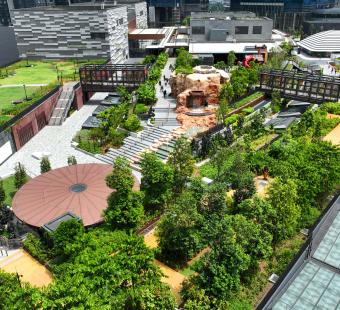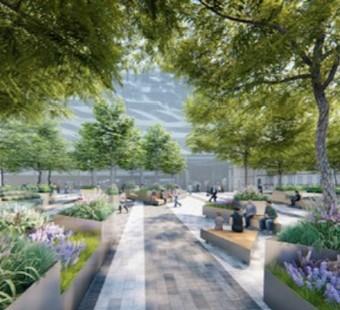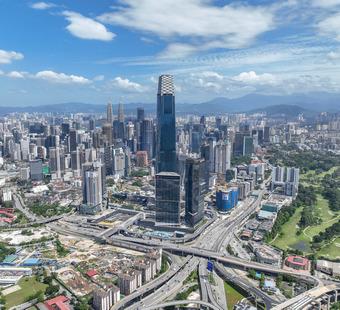TRX's dynamic public realm masterplan has already won awards, not least for its commitment to bring back local flora and fauna to the city centre.
Focused around a new 10-acre city park, roughly a quarter of the whole TRX district will be dedicated to a green public realm designed to showcase the country’s tropical biodiversity. Close to a thousand plants, trees and shrubs are being planted in its open green public realm, with over 90 percent of them being native or naturalised to Malaysia.
“It’s important that we preserve these natural treasures, right in the heart of our city centre,” says Dato’ Azmar Talib, CEO of TRX City Sdn Bhd.
Redefining the urban jungle
Even the overall design of the district takes inspiration from local fruits, such as nutmeg and mangosteen, in such a way that the buildings form the tough outer layer that protects a green heart, namely the elevated, multi-tier city park.
Yet, the really important test in order to truly bring the jungle back into the city in a harmonious way that enhances urban life - whether human, animal or insect - lies in the crucial choice of flora used throughout the district.
Large trees serve as anchors, lining elegant avenues and providing naturally shady canopies. TRX’s famed Merdeka Tree, at the centre of the Northwest Plaza, is a large Pokok Hujan-hujan or widely known as Raintree, (Samanea Saman) as old as the country itself.
These trees, which can reach a height of 15 to 25 metres, will crisscross the district, creating a cooling natural tunnel effect for pedestrians. The fast-growing and hardy species that can thrive in a harsh urban environment also plays host to epiphytes, such as the bird’s nest fern, staghorn fern and pigeon orchids, which further enhances its contribution to ecological health.
Interestingly, the tree’s leaves have a unique habit of folding in the evening and in rainy weather, thus it is popularly known as the “Rain Tree”. It sports small clusters of lightly fragrant, pinkish-white flowers, making it a favourite of birds, bees and insects.
Other foci plants selected sport eye-catching features that will colour the whole district, such as the Kemuning Putih (Murraya Paniculata), which flowers throughout the year and dazzles with red ornamental fruits, as well as the Putat (Barringtonia Acutangula) tree’s distinct flowers, with long racemes and bright red stamens, looking very much like fancy caterpillars. Young putat leaves are also commonly used as ulam (raw salad leaves), accompanying popular local dishes.
The Geronggang Derum (Cratoxylum Formosum) will definitely become a star draw, with flowers that resemble the Japanese sakura or cherry blossom. Between June and August, when the tree blooms, expect a picturesque flowering scene above and a pink carpet below on the TRX Park floor. The Geronggang Derum is not just attractive to humans; it has been identified as a biodiversity champion, bringing birds and butterflies into the area.
Supporting a healthy life cycle
“We are aiming to create a unique and interesting ecological corridor for pedestrians and wildlife,” says Phua Chin Eng, Managing Director of Landart Design, one of TRX's public realm consultants.
He gives the example of the short flying spans of urban birds, butterflies and bees, which meant ensuring the spaces between pockets of green would not be too far apart.
Incorporating water features that would maximise water cycle sustainability and selecting the types of trees, shrubs and plants best suited for a healthy dependence between species are also crucial.
Besides the Rain Tree, other trees that are especially good at encouraging avian life were selected, such as the large Ara Jejawi (Ficus Microcarpa) and medium-sized Jambu Arang (Syzygium Cumini).
The evergreen Ara Jejawi is a fig species native to the Malay Archipelago, and boasts a massively spreading canopy and tasty fruits, popular with birds, squirrels, bats and even monkeys! Similarly, the Jambu Arang’s sweet and sour dark purple berries are a source of food for urban birds. Interestingly, the antibacterial properties of its leaves are used in folk remedies to strengthen gums and teeth.
Birds and blooms rely on pollinating insects, such as wasps and bees. This is where trees like the Gelam Tikus ((Syzygium Antisepticum) come in. With prominent red trunks and flaky bark, the Gelam Tikus will be used as feature trees along the boundaries of TRX. Its glossy dark green foliage is peppered with small berry-like fruits and tiny white flowers, popular with nectarivorous insects, like butterflies and bees.
The ecosystem has been curated to hopefully attract over 18 species of birds and 28 butterfly species.
Protecting endangered species
Preserving the green natural treasures of Malaysia meant making room for plants whose existence has become threatened. Famed since ancient times, the Gaharu (Aquilaria Malaccensis) produces a fragrant resin much sought after as a perfume. Unfortunately, the demand has led to the species being critically endangered in the wild. Its inclusion in TRX goes beyond preservation, making use of the tree’s excellent air purifier qualities to remove traffic pollutants.
Another critically endangered species that will be included in the TRX public realm is the beautiful Pelawan tree, native to the coastal forests of the region. With narrow blades of leathery leaves, the Pelawan also features a colourful trunk that peels frequently, revealing bright orange bark that matures to grey.
In considering every aspect of healthy ecological co-dependence - besides flora choice to include the trajectory of the sun, suitable shading and cooling for a tropical climate, design solutions to encourage walkability, and even local ecological history - the TRX developers are going for something beyond what we have seen before.
“When you have more green, natural environments in cities, people are happier and healthier,” Landart Design’s Phua surmises.
All in all, the TRX Park and the TRX public realm look set to revolutionise urban living in Kuala Lumpur.
---














